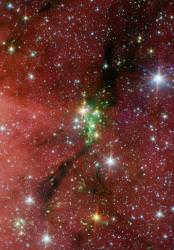This newly released photograph taken by the Spitzer Space Telescope is of a previously hidden star cluster, revealed now in the infrared spectrum. At visible wavelengths, this cluster, located in the southern portion of the Serpens cloud would be totally obscured by dust. But now, thanks to Spitzer, we can see it for the first time.
The cluster was discovered by Robert Gutermuth and Tyler Bourke, from the Harvard-Smithsonian Center for Astrophysics. They originally uncovered it using the Spitzer Space Telescope, but they weren’t able to determine whether they were forming a new “family unit”, or whether they were part of an existing cluster. Follow on observations with the Smithsonian’s Submillimeter Array (SMA) let them measure its velocity; the newly discovered clouds are drifting at the same velocity as the rest of the Serpens star-forming cloud.
In the Spitzer image, the newly discovered Serpens South stars are the green, yellow and orange points of light. That black line that runs through the image is actually a dense patch of gas and dust which is currently condensing to form stars. The green areas are hot hydrogen gas. And the wisps of red indicate regions where there are large quantities of organic molecules called polycyclic aromatic hydrocarbons. You might find similar particles on your barbecue grill, or coming out your car’s exhaust pipe.
The discovery was made as part of the Gould’s Belt Survey. This is a study of all the prominent star-forming regions located within 1,600 light-years of Earth. Photographs from Spitzer as well as several other ground-based telescopes will be merged together into a large data set that astronomers can study for years to come.
Original Source:Centre for Astrophysics

